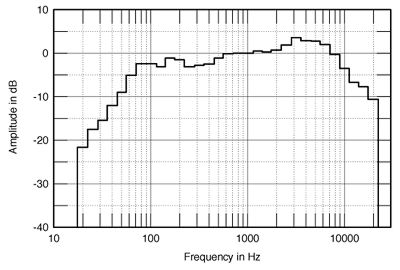| Columns Retired Columns & Blogs |
Acoustic Energy AE1 loudspeaker 1988 Measurements
Sidebar 1: 1988 Measurements
The frequency response of the Acoustic Energy was measured in the listening window—spatially averaged to minimize room standing-wave problems—using a 1/3-octave warble-tone generator; in addition, the nearfield low-frequency response of each speaker was measured with a sinewave sweep to get an idea of the true bass extension relative to the level at 100Hz. The change of impedance with frequency and the voltage sensitivity (using 1/3-octave pink noise centered on 1kHz) were also measured.
A notable point about the plot of the AE1's impedance against frequency (fig.1) is its high value. My measured minima were 8 ohms at 200Hz and 10.5 ohms at 2900Hz and 5430Hz; other than at those frequencies, the impedance rarely dropped below 11 ohms, suggesting that just about any amplifier will be capable of driving the AE1s, as long as it can swing enough volts. The use of a metal cone for the woofer obviously hasn't resulted in any sensitivity penalty (as would be indicated, for example, by a very low impedance in the lower midrange/upper bass). Other than that, there are no surprises, the basic box resonance being tuned to a high 86Hz and the twin ports to a still high 55Hz. Despite the highish modulus of impedance, the voltage sensitivity was pretty much on spec at slightly higher than the reference SL600 at 83.5dB/W/m, though this is still low in absolute terms (one of the consequences of the small box size).

Fig.1 Acoustic Energy AE1, electrical impedance. (2 ohms/vertical div.)
Measured in the nearfield, midway between the woofer and one of the ports, the LF -6dB point lay at 42Hz, the approximate frequency of the double bass's bottom E string. Being a reflex design, however, the roll-off was quite rapid, as can be seen from the spatially averaged in-room measurement (fig.2). There is useful bass down to 50Hz, but then zip. The in-room response is distinguished by a slight rising trend through the midrange, but with a very smooth characteristic overall. As always seems to be the case, there is a little too much energy in the room in the lower octave of the tweeter's passband. This, however, doesn't necessarily mean that the direct-field response of the speaker has a peak in this region, interpretation of these in-room graphs not always being straightforward.

Fig.2 Acoustic Energy AE1, spatially averaged, 1/3-octave, free-field response in JA's original Santa Fe listening room.
The peak you see here between 2kHz and 8kHz is primarily due to the fact that the tweeter virtually radiates into a hemisphere at these frequencies, as its dimensions are smaller than the wavelength of the soundwaves. These frequencies will therefore make a larger contribution to the room sound, which is reflected in my measurement. I therefore have to use some caution when deciding whether there is too much of a peak in this region. In this case, there seems to be just about the right amount of low-treble boost in the room measurement to suggest a flat treble response overall. The extreme high-frequency roll-out is a little more severe than I would have liked to see, but is basically smooth and well-controlled.
The trace in fig.2 was taken in my earlier room in Santa Fe, which was a room designed for minimum excitation of low-frequency resonances (see "A Matter of Taste," January 1988, p.175). Repeating the measurement in my later Santa Fe room, a room that is is more typical in being a basically rectangular space, gives a trace (fig.3) that is virtually identical in the upper midrange and treble, but less even in the bass. In particular, the 63Hz band kicks up a little, while the reflection from the floor between the speaker and listener results in a slight lack of energy between 200Hz and 400Hz.—John Atkinson

Fig.3 Acoustic Energy AE1, spatially averaged, 1/3-octave, free-field response in JA's later Santa Fe listening room.
- Log in or register to post comments




































